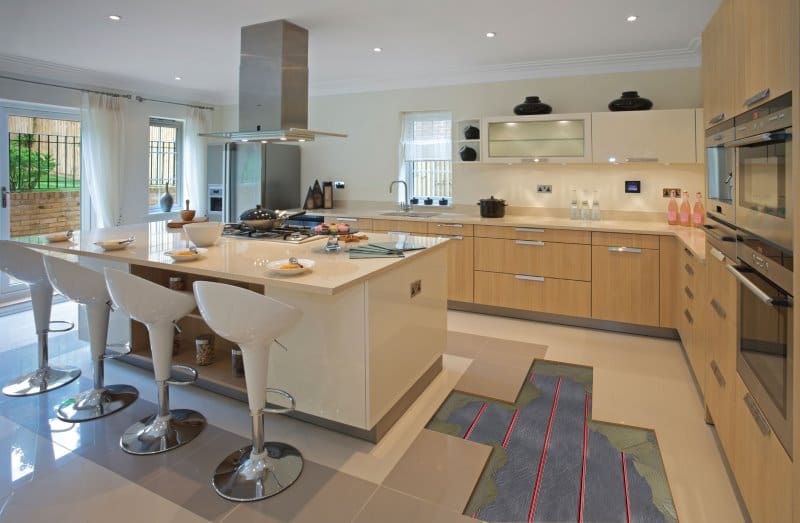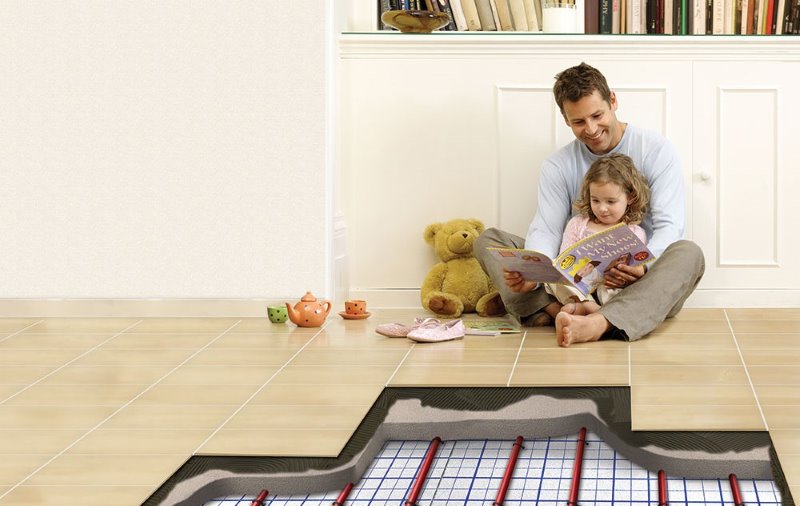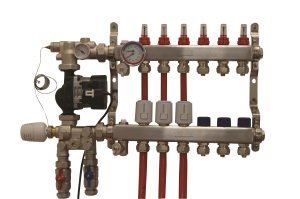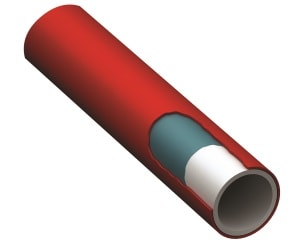Thinking about installing a Warmup Water Underfloor Heating System for your next project? Find out more about the basic principles of water systems and the range of products available from Warmup.
In this blog we will answer to the following 6 questions:
- What is Water Underfloor Heating?
- How do Hydronic Systems work?
- What are the benefits of Water Floor Heating?
- What kind of project is a Water System suitable for?
- Which Pipe is right for my project?
- Which Warmup Water System is right for my project?

What is Water Underfloor Heating?
Water Underfloor Heating (UFH), also known as Wet, Warm Water Pipe or Hydronic floor heating, is a heating system that pumps heated water from a combination boiler or other heating source through pipes within the floor construction; gradually heating the room from below for a much more efficient heating solution. This process produces predominantly radiant heating, whereby the floor itself is initially heated and this, in turn, radiates heat directly into the occupants and furniture. As opposed to Convection Heating (such as a traditional radiator-based system) which works by heating the air itself, resulting in convective drafts, wasted energy and higher energy bill costs.
> View Warmup Hydronic System Range Here
How Do Hydronic Systems Work?
Wet floor heating systems are gaining in popularity with energy-conscious consumers aware of the impact of both energy wastage on the environment and their bill payments. Well-insulated houses should be installed with an equally efficient heating system; water UFH systems work very well in this combination to create a truly energy-efficient home.
Installation
Once you have chosen a specific Warmup UFH System to suit your project’s requirements (see below for more information on the complete Warmup Hydronic range), the installation itself is simple to complete. The floor pipes can be laid down in various patterns that provide optimal heat distribution and are connected via a Warmup Manifold, Mixing Unit and Control Centre, to the heat source. For added efficiency lay the pipes on top of Warmup Insulation Boards. If using an existing boiler, check that it is compatible with a Warmup System. You can also install wet underfloor heating using alternative heat sources such as a solar thermal, bio-mass, ground source or air source heat pumps
Manifold
The Manifold is an advanced piece of engineering that when combined with a mixing unit, blends hot water from your heat source with cooler water from the floor circuits to provide and pump through the ideal flow temperature of water for the circuits heating needs. A mixing unit is required in most heating systems however where the heat source can provide the primary temperature low enough to meet the design needs, a mixing unit may not be needed (most commonly with air and ground source heat pumps). The manifold also acts a centralised hub for the floor heating system’s ‘zones’ – utilising a zone actuator and zone valves and allowing your space to be divided into independently managed areas for efficient, regulated control.
> View Warmup Manifold Here
Thermostat
Using a Warmup underfloor heating Thermostat alongside the Manifold, Mixing Unit and Control Centre allows intuitive control of the Hydronic System. The thermostat communicates with the wiring system which in turn communicates with the heat source, mixing unit and zone actuators and valves (if fitted) to detect when a specific zone is up to the correct temperature. When the primary heating circuit has reached a flow temperature of between 55 – 75°C (25-55°C for heat pumps and solar) and the thermostat is calling for more heat, the control unit will begin to run. When the air temperature in the room reaches the required set point, the thermostat will shut off the heating. If the primary heating temperature drops below a set level, then the control unit will automatically shut itself down to avoid circulating cool water round the heating system and wasting energy. This is regardless of the temperature set on the thermostat and greatly enhances energy-efficiency.
What Are the Benefits of Water Floor Heating?
- Hydronic systems are proven to be much more energy-efficient than conventional heating options, preventing energy wastage and saving money on heating bills
- Wet floor heating is effortless to run, running automatically when connected to a Warmup Thermostat – allowing self-regulation and never overheating, or underheating a home. Warmup systems need virtually no maintenance and come with extensive guarantees for your peace of mind.
- With a hydronic system there is, of course, no need for radiators anymore. This allows your project to have more wall space and more freedom to design, decorate and inhabit.
- Warm water underfloor heaters are easy to install and work with all floor coverings – whether the floor finish will be natural wood, vinyl, stone tile, carpet or poured concrete, Warmup Hydronic Systems are ideal for your needs.
- Radiant heat is also much better for the air quality of the room, keeping it fresher than when heated by conventional radiators and removing the problem of dust circulation caused by radiators raising and lowering particles.> Read the blog about the ‘Pros and Cons of UFH’
What Kind of Project Is a Water System Suitable for?
All of Warmup’s Water Heating Systems are ideal for new-build construction projects.
For existing builds and renovation projects, we offer a range of floor heaters to suit your requirements. Our Total-16 System is specifically designed for renovation projects, being a low-profile floor heater at just 16mm in depth – adding negligible floor height to a room. The Econna Joisted Floor System is another low-profile system designed to be used as a structural floor with no need for screeding. Our Tectora Joisted Floor System is also recommended for renovation projects and is ideal for use with battened or suspended timber floors with a concrete sub-floor.
If you need any assistance with how best to incorporate a Warmup floor heater in your project, we are happy to help. With over 20 years’ experience of working with architects, self-builders and contractors, Warmup offer a thorough consultation service assisting you in selecting the ideal system for your requirements. Warmup can work with you from the design stage of your project, through quotation and to the final delivery and installation of your chosen wet system and guarantee you a successful result.
Which Pipe Is Right for My Project?
All of Warmup’s Hydronic Systems use one of Warmup’s advanced underfloor heating pipes to carry warm water from your heating source, through the Manifold and underneath the floors of your home for an energy-efficient, cost-saving heating solution.
There are three Warmup pipes for you to consider using in a Warmup Water System. All three are strong, resistant to damage and flexible – allowing a hassle-free installation.
The PEX-A Pipe comes in either 12mm or 16mm and is formed as a single extrusion with an adhesive layer and EVOH oxygen barrier, preventing the risk of corrosion.
The PE-RT Pipe is a transparent 16mm 5-layer extrusion with an oxygen barrier and is ideal in situations where the temperature does not exceed 70 degrees Celsius.
The AL-PE-RT Pipe is a 16mm 5-layer composite pipe, with layers of PE-RT, adhesive and an aluminium core for a total oxygen barrier.
These pipes are used within the wet heating system of your choice. The optimal Warmup Water System for your project ultimately depends on the floor construction design – whether you are installing a system onto floating floors, battened or joisted floors or structural floors.
> View Warmup Pipe Here
Which Warmup Water System Is Right for My Project?
1. Systems for Floating Floors
A floating floor is simply a floor finish that does not need to be attached to the sub-floor beneath it. When installing wet floor heating system, you would typically lay the heating pipes on top of insulation boards over the sub-floor then screed over the system before laying your final floor finish on top.
The Total-16 Low Profile System is a low profile wet underfloor heating kit and is perfect for renovation projects due to its shallow depth (uses the 12mm PEX-A Pipe).
The Clypso Floor System is recommended for floating screeded floors and uses clips to attach the floor heating pipe to the included insulation boards.
The Nexxa Panel System uses a nodule-based insulation board to wind the heating pipes around.
The Metro Rail System is a rail-based system allowing fast installation.
The Contura Floating Floor System is specifically designed for screed-less floating floors

2. Systems for Joisted/ Battened Floors:
Battened or joisted floors are typical of traditional timber-based housing construction, whereby the floors are supported by wooden joists. A Warmup Hydronic System can be laid between or on top of these joists.
The Silva Joisted System is designed for use with battened or suspended timber floors.
The Econna Joisted Floor System is for use with battened or joisted floors and sits on top of the joists, allowing the void between them to remain free.
The Tectora Joisted Floor System uses aluminium plates to spread heat quicker.
3. Systems for Load-bearing, Structural Floors
A structural floor is often part of the foundation of the building and therefore must be strong enough to support significant load. Warmup have one specific system designed for such a need.
The Forte Grid System is ideal for reinforced concrete and uses a metal gridwork for installation.
All of Warmup’s Water Heaters come with extensive warranties and a SafetyNet Installation Guarantee’ that covers you against accidental damage of the UFH pipes during installation
Contact Warmup‘s expert team of designers and engineers to assist you with your project’s Wet Heater specifications or for a more in-depth breakdown of a specific system’s technical specifications, view our system range. You can find Installation Manuals for all Warmup Water Systems on their respective product pages.
> View Warmup Hydronic System Range Here
> Get a Free Quote Here



















